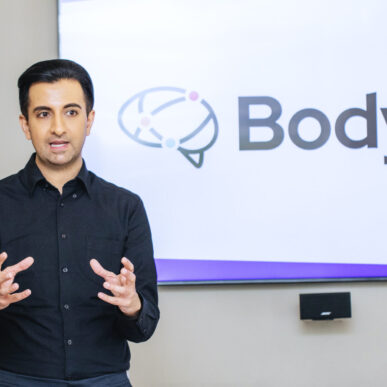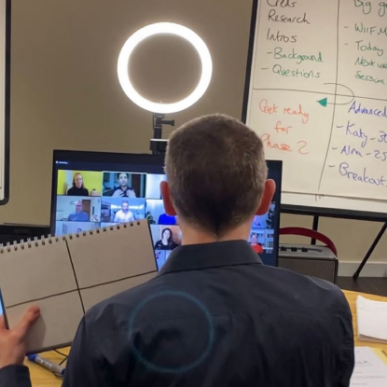How many times have you been in a meeting, watching someone talk through a dreadfully dull dashboard presentation or a report slide? You know the type I mean: an overwhelming chart full of numbers, percentages, graphs, trends and statistics, written in a tiny font and rattled off at lightning speed.
You nod along, but let’s be honest—you’re not entirely sure what the important points are, as you’re starting to feel a bit sleepy.
Maybe you’re the one giving the presentation. You have lots of data that you need to share, but you’re not sure about how to make your audience care about it.
This is exactly why data literacy matters. It’s not just about understanding numbers – it’s about knowing how to interpret, analyse and communicate data in a way that matters to your business and your audience.
What Is Data Literacy – and Why Should You Care?
Data literacy is the ability to read, understand, analyse and communicate information effectively. It’s knowing how to find meaning in facts and figures and make decisions based upon that information.
Business leaders, sales teams, marketers and even HR professionals all rely on data to back up their strategies. If you can’t interpret the data – or worse, if you misinterpret it – you risk making poor decisions, losing credibility, or missing opportunities. And with more and more businesses relying on AI resources to support their data, it’s more important than ever for humans to be data literate!
More and more businesses are recognizing that data literacy is not just a technical skill—it’s a communication skill. The ability to tell a compelling story with data is just as important as the data itself.
Who Needs Data Literacy Skills?
Data literacy is not just for number crunchers and analysts—it’s for anyone who wants to make informed decisions, influence others and communicate with confidence in today’s data-driven world.
Not too long ago, understanding data was seen as a skill for specialists: if you needed insights, you’d call in the data team. Now, whether you’re pitching a new idea, leading a team or delivering a presentation, being able to confidently interpret and explain data is essential.
The Evolution of Data Literacy
Data literacy has evolved significantly over the past few decades. Here’s how:
1. The Early Days: Paper and Ledgers
Three quarters of a century ago, the concept of data literacy did not exist as it does today. Back in the 1950s, most large companies still relied on ledgers and handwritten records to track data, and business decisions were often based on experience and intuition rather than hard numbers. Although these methods had worked well for centuries, relying on humans to do all of the work was much less accurate and not especially scalable.
2. The Digital Revolution: Data at Our Fingertips
The 1960s saw businesses adopting computers and using digital databases to store and analyse information. This was a game-changer—suddenly, data could be processed much faster and more efficiently. As computers became more affordable, software became much more advanced and the digital revolution brought huge sets of data to our fingertips. Nevertheless, even by the 90s, data literacy was still considered to be a specialist skill.
3. The Internet Boom: Information Overload
The internet boom of the 1990s and early 2000s revolutionised access to information, making vast amounts of data available to people around the world. The rise of user-friendly software like Excel and the proliferation of online databases made it easier for non-specialists to analyse and use data. This shift ultimately transformed data literacy from a specialised skill to a more common, essential competency for many professions.
4. Big Data and AI: Data Becomes Essential
Today, companies collect enormous amounts of data on everything from customer behaviour to market trends. Artificial intelligence and machine learning help process and analyse this data, but without strong data literacy, people struggle to understand and apply insights correctly.
Data Literacy in Business: Things to Consider
Organisations that prioritise data literacy build teams that are more confident, more strategic, and less likely to glaze over in meetings when a spreadsheet appears. Leaders who embrace it don’t just make better decisions; they inspire trust, credibility, and influence.
Here are some tips to help you interrogate your data and make it more meaningful.
- Know your sources – Where is your data coming from? Can you trust it? It can be too tempting to run with data that appears to fit our narrative or preconceptions – but a little scepticism goes a long way. Not all data is accurate or unbiased. Always question the source, methodology, and context. Next time you’re faced with a graph or a set of numbers, don’t just accept them at face value. Dig a little deeper, ask the right questions, and make sure you really understand what the data is saying.
- Find the message – The best communicators don’t just share data; they translate it into something understandable and relevant. Look beyond the numbers and ask yourself: What is this really saying? What’s the most important message or key takeaway that your data is showing? Why does this data matter? What problem does it solve? When you’ve found it – double check it. Make sure you keep your message simple, avoiding jargon and unnecessary complexity.
- Tell a story – People don’t naturally connect with raw data, but they do connect with stories. By framing data within a compelling narrative, you can make complex information easier to understand, influence decisions more effectively and keep your audience engaged rather than overwhelmed.
- Use visuals (carefully) – Charts, graphs, and infographics can bring data to life, but having too much on a screen at once can obscure your message and make it challenging to follow. Use clean, clear graphics and keep on-screen data to a minimum so that your audience stays engaged.
How to Improve Your Data Literacy
Curious about improving your own data literacy skills? Start small, stay curious, and remember: data isn’t scary. It’s just another way of telling a story—the better you tell it, the more impact you’ll have.
If you’d like support in finding the story within your data, we’d be happy to help. Get in touch with us today.


















